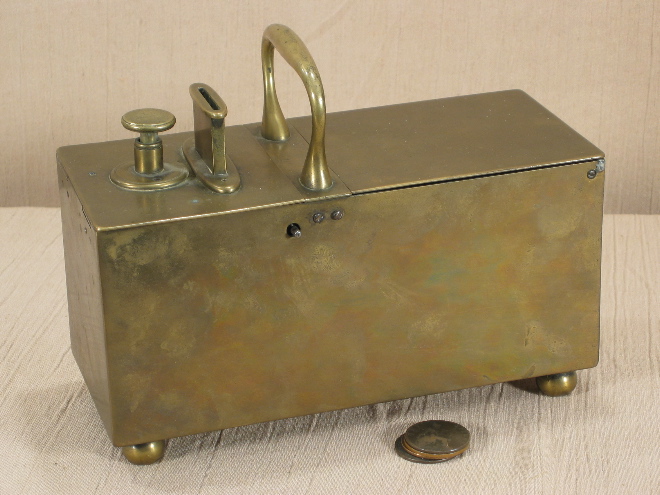___________________________________________________________________________________________
Honor Box

___________________________________________________________________________________________

Custom made by makers unknown, c. mid-1700's to mid-1800's, 7 1/4". This is an interesting piece that I didn't appreciate until I spent time talking to the owner of one and got to inspect his carefully. His name was Walter Reed and he was the spokesman for the vending industry (sorry, I meant the automatic merchandising industry) from 1958 through the early 1980's. After he assumed that position in 1958, he decided that he wanted to own an example of the oldest vending machine known to exist, and this is it. He bought his first Honor Box in 1962 and then bought others whenever he had the chance, until he ended up with four. He kept them until the spring of 2006 when he sold 3 at the Chicagoland show. He kept the last one for his son.
He'd researched the history of the model and believes that the first one was made about 1750 or 1760 and they continued to be made through about 1840 or 1850. Compared to most models we collect, this one's downright ancient. It's impossible to know exactly when they were made because they were built by individual craftsmen before the industrial revolution, so there's no central cache of manufacturing records to review.
They were first made in England, where they were called "trust boxes" and were used in taverns. I'd be surprised if they weren't also made in other countries later, especially other countries of the current United Kingdom, but I don't know that to be fact. The customer put a large English penny into the coin slot, pushed the button, and the lid to the other half of the box popped open. The customer was on his honor to take only a single serving of pipe tobacco or snuff and then to close the lid after he was done. By tradition, the tavern owner's wife owned the money inside the box, although I don't know if she was expected to use that money to restock the box when the product ran low. Most honor boxes have the tavern owner's name inscribed on the box, usually under the handle.
One reason I didn't appreciate these was that I thought the coin wasn't required to open the product compartment. I thought paying was part of the trust, in which case this would be a bank, not a vending machine. The product lid won't open without the coin, though, making this a legitimate vending machine. From this picture you can see the mechanism under the coin slot; it's simple and crude for a "normal" vending machine, but considering the era of this thing I think it's pretty well done.
The Honor Box has been reproduced. I've not seen one live, but I was told that the distinguishing characteristic of the reproductions is some type of prominent mark on the top of the button you push to open the product compartment.
The example pictured above is 100% original. As far as I know all honor boxes are made of brass, so it'll get a great old patina if you leave it alone and let it age naturally.
___________________________________________________________________________________________
___________________________________________________________________________________________
©Small Vintage Vending 2003-2009